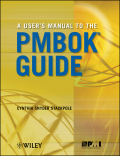
The PMBOK(r) Guide is a professional standard (actually is is a registered standard with the American National Standards Institute - ANSI). It is a technical document and has never been intended to be user friendly. Yet more and morepeople use this document as a recipe book for how to manage a project. While the intent is good the standard is not designed to be easy to understand or toimplement. Our successful author, Cyndi Stackpole, who was project manager ofthe development of the PMBOK Guide itself, has paved the way toward working successfully with PMI with her recently published: "A Project Manager's Book ofForms: A Companion to the PMBOK Guide". With the proposed she is taking it tothe next logical level and writing a true user's manual to the standard. The author has already approached PMI and they are reviewing her proposal with an eye toward co-branding this book as was done for the forms book. Because of the close nature of the proposed to the PMBOK Guide we will either need to co-brand or potentially pay licensing fees each year to PMI. Either way - the proposed content will be "must-have" for any project manager or those studying for the PMP Exam INDICE: Preface. Acknowledgments. Chapter 1 Introduction. About This Book.Project Management Process Groups. Project Management Knowledge Areas. Chapter 2 Key Concepts. Projects, Programs, and Portfolios. Project Life Cycles. Progressive Elaboration. Tailoring. Project Management Plan and Project Documents. Enterprise Environmental Factors. Organizational Process Assets. Chapter 3 Initiating a Project. Initiating Process Group. Project Sponsor Role. Project Manager Role. Develop Project Charter. Identify Stakeholders. Chapter 4 Planning Scope. Planning Process Group. Planning Loops. Project Scope Management. Collect Requirements. Define Scope. Create WBS. Chapter 5 Planning the Schedule. Project Time Management. Define Activities. Sequence Activities. Estimate Activity Resources. Estimate Activity Durations. Develop Schedule. Chapter 6 Planning Cost. Project Cost Management. Estimate Costs. Determine Budget. Chapter 7Planning Quality. Project Quality Management. Plan Quality. Chapter 8 Planning Human Resources. Project Human Resource Management. Develop Human Resource Plan. Chapter 9 Planning Communications. Project Communications Management. Plan Communications. Chapter 10 Planning Risk. Project Risk Management. Plan RiskManagement. Identify Risks. Perform Qualitative Risk Analysis. Perform Quantitative Risk Analysis. Plan Risk Responses. Chapter 11 Planning Procurement. Project Procurement Management. Plan Procurements. Chapter 12 Planning Integration. Project Integration Management. Develop Project Management Plan. Chapter 13 Executing Quality Management. Executing Process Group. Perform Quality Assurance. Chapter 14 Executing Human Resource Management. Acquire Project Team. Develop Project Team. Manage Project Team. Chapter 15 Executing Communications Management. Distribute Information. Manage Stakeholder Expectations. Chapter 16Executing Procurement Management. Conduct Procurements. Chapter 17 Executing the Project. Direct and Manage Project Execution. Chapter 18 Monitoring and Controlling Scope. Monitoring and Controlling Process Group. Verify Scope. Control Scope. Chapter 19 Monitoring and Controlling the Schedule. Control Schedule. Chapter 20 Monitoring and Controlling Cost. Control Costs. Chapter 21 Monitoring and Controlling Quality. Perform Quality Control. Chapter 22 Monitoring and Controlling Communications. Report Performance. Chapter 23 Monitoring and Controlling Risk. Monitor and Control Risks. Chapter 24 Monitoring and Controlling Procurement. Administer Procurements. Chapter 25 Monitoring and Controlling the Overall Project. Monitor and Control Project Work. Perform Integrated Change Control. Chapter 26 Closing the Project. Closing Process Group. Close Procurements. Close Project or Phase. Index.
- ISBN: 978-0-470-58489-7
- Editorial: John Wiley & Sons
- Encuadernacion: Rústica
- Páginas: 240
- Fecha Publicación: 06/10/2010
- Nº Volúmenes: 1
- Idioma: Inglés
